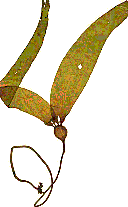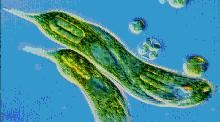| Golden Algae | Usually one-celled | These protists keep food reserves in an unusual way - they store them as drops of oil. This group is mostly flagellates and only rarely reproduce sexually. |  |
| Green Algae | filamentous, one celled or colonial | Though this group is most commonly in the water, it can be found on snow, treetrunks, and in the soil. This group is most similar to land plants. |  |
| Red Algae | One-celled or may be more complex. Leaf-like. | This algae is responsible for poisonous algal blooms which kill off animals in the water. Most interesting are this protist's economic uses. Most likely you've eaten red algae without ever knowing it. |  |
| Brown Algae | Usually multi-cellular, can be gigantic | This is the group most commonly thought of when the term "seaweed" is used. Giant kelp forests of Sargassum brown algae exist. These have similar structures to land plants. There are stalks and leaves, but also they have air bladders to keep the algae aimed at the sun. |  |




 When you look this closely at algae, you notice that they don't resemble plants too closely. These little critters are euglena. They resemble the animal like protists. They have the ability to move, they have the same shape, and they even have flagella, or whip-like tails. They're plant-like though. They produce their own food. The chlorophyll inside of them allows them to harness solar energy.
When you look this closely at algae, you notice that they don't resemble plants too closely. These little critters are euglena. They resemble the animal like protists. They have the ability to move, they have the same shape, and they even have flagella, or whip-like tails. They're plant-like though. They produce their own food. The chlorophyll inside of them allows them to harness solar energy. There are many algaes of importance. Diatoms are very interesting. These are plant-like, but they have shells, and the shells are microscopic beauties. These are part of the group known as plankton. Plankton is a general term for very small or microscopic organisms floating about in the water. Many marine animals are dependent on the plankton. Even many whales, the largest mammals, are dependent on these tiniest of organisms.
There are many algaes of importance. Diatoms are very interesting. These are plant-like, but they have shells, and the shells are microscopic beauties. These are part of the group known as plankton. Plankton is a general term for very small or microscopic organisms floating about in the water. Many marine animals are dependent on the plankton. Even many whales, the largest mammals, are dependent on these tiniest of organisms.